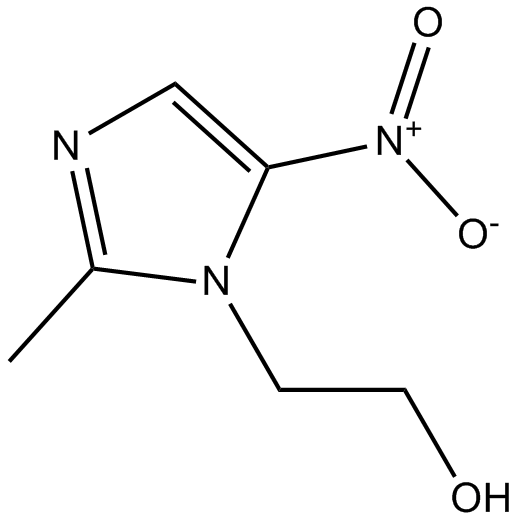Metronidazole (Synonyms: MNZ, NSC 50364, NSC 69587) |
| Catalog No.GC15775 |
nitroimidazole antibiotic
Products are for research use only. Not for human use. We do not sell to patients.

Cas No.: 443-48-1
Sample solution is provided at 25 µL, 10mM.
Metronidazole is a nitroimidazole antibiotic medication used particularly for anaerobic bacteria and protozoa.Target: Antibacterial; AntiparasiticMetronidazole is a nitroimidazole antibiotic medication used particularly for anaerobic bacteria and protozoa. Metronidazole is an antibiotic, amebicide, and antiprotozoal.[1] It is the drug of choice for first episodes of mild-to-moderate Clostridium difficile infection [2]. Metronidazole, taken up by diffusion, is selectively absorbed by anaerobic bacteria and sensitive protozoa. Once taken up by anaerobes, it is non-enzymatically reduced by reacting with reduced ferredoxin, which is generated by pyruvate oxido-reductase. Many of the reduced nitroso intermediates will form sulfinamides and thioether linkages with cysteine-bearing enzymes, thereby deactivating these critical enzymes. As many as 150 separate enzymes are affected.In addition or alternatively, the metronidazole metabolites are taken up into bacterial DNA, and form unstable molecules. This function only occurs when metronidazole is partially reduced, and because this reduction usually happens only in anaerobic cells, it has relatively little effect upon human cells or aerobic bacteria.[3]
References:
[1]. In Schaechter, M.; Engleberg, N. C.; DiRita, V. J. et al. Schaechter's Mechanisms of Microbial Disease. Hagerstown, MD: Lippincott Williams & Wilkins. p. 28.
[2]. http://www.drugs.com/monograph/metronidazole.html
[3]. Cohen, S.H., et al., Clinical practice guidelines for Clostridium difficile infection in adults: 2010 update by the society for healthcare epidemiology of America (SHEA) and the infectious diseases society of America (IDSA). Infect Control Hosp Epidemiol, 2010. 31(5): p. 431-55.
Average Rating: 5 (Based on Reviews and 32 reference(s) in Google Scholar.)
GLPBIO products are for RESEARCH USE ONLY. Please make sure your review or question is research based.
Required fields are marked with *




